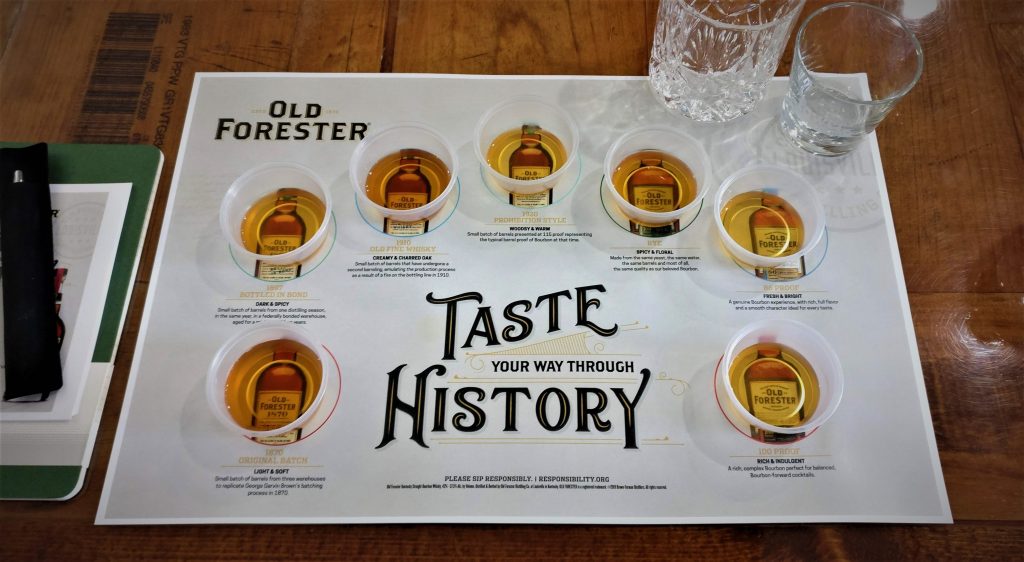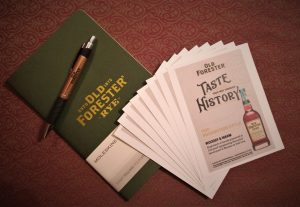Old Forester – Taste Through History
Old Forester – Taste Through History
with Master Taster Jackie Zykan
Thursday, May 30th 2019 – $15 per person
Tower Tasting Room
5877 Buford Highway, Suite A
Doraville, GA 30340
We would like to thank Brown-Forman and Weber Shandwick for the complimentary invitation to the event!
Event Description
Please join us for a tasting of Old Forester and a chance to meet Master Taster Jackie Zykan.
We will be sampling:
1910 Old Fine Whiskey
1870 Original Batch
1897 Bottled in Bond
1920 Prohibition Style
Event Review
The Tower Tasting Room sits off the side of Tower Beer, Wine & Spirits in Doraville, GA, with an independent entrance from the retail store. They host various events such as this, and if you’re local to Atlanta, I’d recommend checking in from time to time. I’ve attended a couple of tasting events here and at their other location, and they have a really nice setup.
Each participant was welcomed with bottled water, 7 samples placed over an image of the originating bottle, and some brief tasting notes – seen below. I’d estimate that the samples were 1/3 to 1/2 ounce each, and all were covered with paper prior to the event kicking off.

We also received an Old Forester pen, a small Moleskine, and cards for each of the products on the placemat (along with one for Old Forester The Statesmen). Appreciated the cards since those were easier to take with than the placemat. Also thankful for the Moleskine, as while I had thought to bring my own pen – I forgot a notebook!

A representative from Old Forester/Brown-Forman did a nice introduction to Jackie Zykan, the Master Taster at Old Forester – including ‘What does a Master Taster do?’ which is a question I had coming into the event. I’ve met many Master Distillers over the years, including Chris Morris (Master Distiller for Brown-Forman, which makes Old Forester along with Woodford Reserve, Early Times, and Jack Daniels), but wasn’t familiar with this role. Easiest explanation offered was ‘Chris Morris oversees what goes into the barrel, Jackie oversees what comes out’. She’s involved in barrel selection for their Whiskey Row series, leading their private barrel program, and also leads the Birthday Bourbon proofing tasting (where they taste what will be bottled as Birthday Bourbon at every proof starting at 86 on up to identify the best proof point for that batch). Jackie’s background includes an education in chemistry and biology, and she started bar-tending before working her way up to a beverage director role, and ultimately where she is now.
She introduced each product, explaining first the historical context and significance of the year, and what they were aiming to represent with each. We’ve done reviews on almost all (working on getting the last one later this month!) so will skip the tasting details but share some of the notes from the history lesson.
1870 Original Batch
– Brown-Forman created Old Forester as a non-distilling producer, batching barrels from three different distilleries to create a consistent profile (they bought the Mattingly distillery in 1901-1902 and begin distilling for themselves).
– This offering is the smallest batch of Old Forester produced (excluding ‘single barrel’ obviously), with only 21 barrels – 7 barrels selected from 3 different warehouses (all distilled by OF, but to get different flavor profiles).
– The average age of barrels batched for this are 4 1/2 to 5 yrs.
1897 Bottled In Bond
– 1897 is when the U.S. Bottled-in-Bond Act was passed, which George Garvin Brown wasn’t a fan of. The intent was to ensure quality – which they had been doing for the last 27 years already. But now they couldn’t bottle the same product with this new ‘quality ensured label’ (to be labeled Bottled-in-Bond, the whiskey must all be produced from the same distillery during the same distilling season, etc).
– This batch (and all other Whiskey Row series products, other than 1870 Original Batch) is comprised of 100 barrels or less.
1910 Old Fine Whisky
– In 1910 there was a fire (not their offices, but a neighbor) which caused their bottling line to be shut down. Waiting to be bottled was a vat of mature whisky already brought down to 100 proof to be bottled. They couldn’t let it sit indefinitely, so they had to put it back into new, charred oak barrels until the bottling line was repaired.
– As the flavor profile of this was different from the Old Forester which was bottled-in-bond, they didn’t label this whisky as Old Forester and instead labeled it as Very Fine Old Whisky to avoid confusion.
– This is the only Old Forester expression that is double-barreled.
– Standard Old Forester barrels are charred for 22 seconds; the second barrels used here are charred for 60 seconds!
– Barrels are dumped at 4.5 to 5 yrs, and cut to 100 proof before going into the second barrel.
– Bottled at 93 proof because frankly – it tasted best at that proof.
1920 Prohibition Style
– During Prohibition, the only whisky made was for medicinal purposes, and was bottled at 100 proof. But with the 1897 Bottled in Bond, wanted to showcase to consumers how it would have tasted straight from the barrel. Back in 1920, their archives show that the proof coming out of the barrels was 115 (note that it was only 100 proof going INTO the barrels back then; today it is 125 proof).
– Side note: I asked Jackie if they have experimented with going into the barrel at a lower proof and might offer such an expression in the future. Understandably she couldn’t talk about future products but did share that they experiment with a lot of different things – and she would love to see them have an offering that goes in at a lower proof, as this would create a sweeter bourbon based on chemistry and stuff (my interpretation; I couldn’t write fast enough to capture the actual chemistry explanation!) While likely delicious, it would be a more expensive bourbon as you’re getting fewer proof-gallons as a result (and the barrel is the most expensive component). Crossing my fingers that we’ll see some limited bottling of Old Forester in the future (maybe ‘100 Proof In & Out?’)
Rye
– While Old Forester never made a rye until their new product, they have bought other brands and recipes, and in 1940 owned the recipe for Normandy Rye (hence why it follows the 1920 on the timeline). The mashbill of 65% rye, 20% malted barley and 15% corn is unique, and Jackie explained that they tested 30 different recipes before settling on this one. A big factor was wanting to avoid the need for added enzymes, as rye can create a foamy mess while fermenting. The higher barley content allows them to avoid the added enzymes, and also adds some unique flavors.
86 Proof
– During the 1950s, there was an explosion of ‘blended whisky’, which can include straight bourbon blended with ‘grain neutral spirits’ to make a lighter spirit in both color and flavor. The 86 proof Old Forester was introduced to meet this market demand. Barrels for this are pulled on their 4th birthday – as young as they can bottle without including an age statement.
100 Proof
– Formerly called Old Forester Signature, this product was introduced during the early 1990s, thanks to the 1980s. Bourbon buffs are familiar with that period, where bourbon wasn’t selling as well and stocks were piling up. Because you can’t sell as ‘bottled-in-bond’ if you have barrels from different distilling seasons, these barrels that were older couldn’t be used in that product so they created Old Forester Signature – bottled at 100 proof but including barrels of various ages.
– Jackie shared that when they are selecting barrels for Birthday Bourbon each year (which are typically 9 to 13 yrs old), the barrels that don’t quite make the cut for that wind up in Old Forester Signature.
While not on the tasting mat, after the conclusion of the Taste Through History they offered a sample of Old Forester Statesman, a bourbon created for the movie The Kingsman: The Golden Circle. I enjoyed it, but after 7 prior samples couldn’t capture detailed enough notes (although received a sample later, which is reviewed here!)
Beyond the history lesson and some insights into each product, I also learned:
1. All Old Forester whisky is non-chill filtered.
2. While Old Forester and Woodford Reserve both use the same mashbill of 72% corn, 18% rye, and 10% malted barley, the barrels used are seasoned differently for Woodford Reserve.
3. The story behind the odd-bottle used in Birthday Bourbon? When they first had the idea of the expression, to release it around George Garvin Brown’s birthday in early September, they were limited to what they could get on about 3 months notice. They didn’t want to use the same bottles used in Old Forester to ensure this differentiated itself. Process of elimination left they with really one choice – what it has been bottled in since.
I thoroughly enjoyed myself, and learned a fair amount too (including where to eat when I finally get to Lynchburg, TN to visit Jack Daniels – Jackie recommended Miss Mary Bobo’s Boarding House as a can’t miss!) Hope if you have the chance to attend a similar event, you’re able to carve out some time (and get a ticket, as these apparently sell out quickly!)


